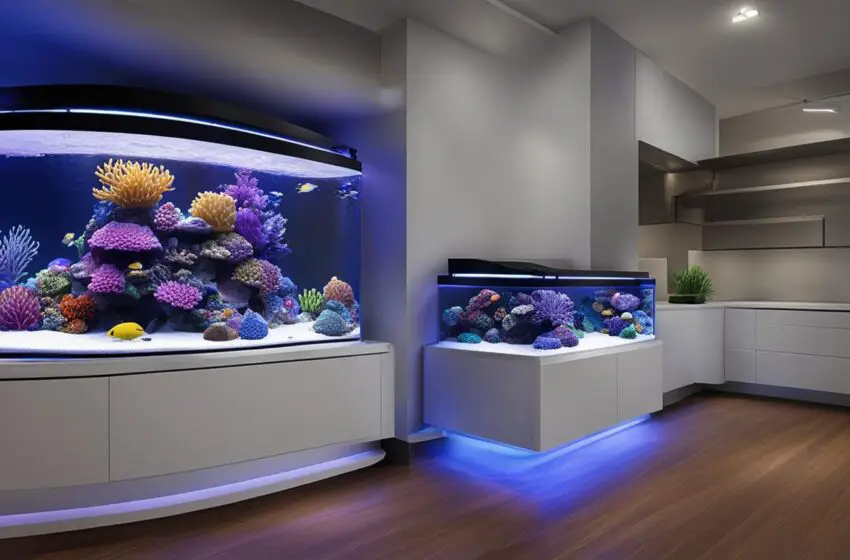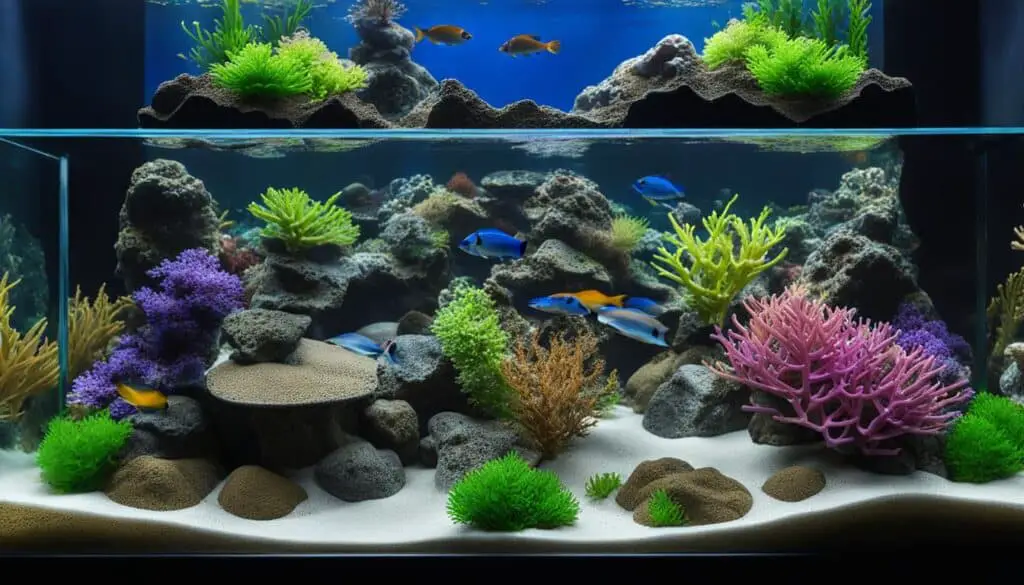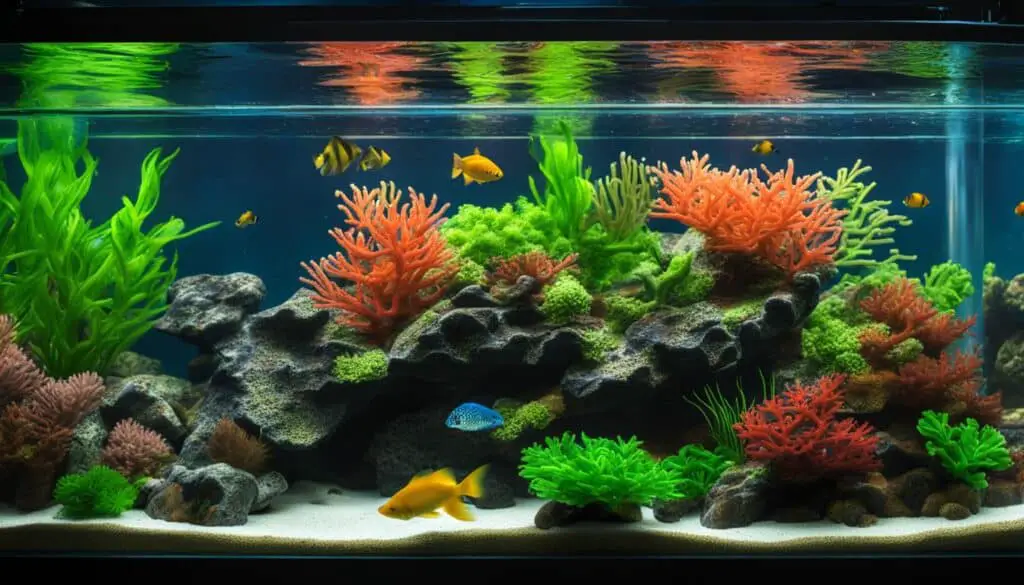The Science of Energy-Efficient Filtration in Marine Tanks

As an avid aquarium enthusiast, I understand the importance of maintaining a thriving aquatic ecosystem in marine tanks. One key aspect of achieving this is through the use of energy-efficient filtration systems. These systems not only provide effective water clarity and enhanced water quality but also contribute to reducing odors and preventing fish diseases. In this article, I will delve into the benefits of utilizing activated charcoal in aquarium filtration, the power it possesses in removing impurities and toxins, and how to effectively incorporate it into your aquarium setup.
Key Takeaways:
- Energy-efficient filtration systems are essential for maintaining a thriving marine aquarium ecosystem.
- Activated charcoal plays a crucial role in improving water clarity, water quality, and odor elimination.
- Using activated charcoal in your aquarium is a simple and effective process.
- Undergravel filters provide efficient biological filtration through the use of nitrifying bacteria.
- Tips for energy efficiency in aquariums include using LED lighting, efficient heating/cooling equipment, and proper insulation.
Understanding Activated Charcoal and its Benefits
Activated charcoal, derived from sources like coconut husks or wood, is highly porous and has an increased surface area, making it ideal for trapping and removing impurities from water. It offers a range of benefits that contribute to the overall health and cleanliness of your aquarium.
Improved Water Clarity
Activated charcoal plays a crucial role in improving water clarity. Its porous structure absorbs and traps microscopic particles, including dirt, debris, and discoloration, resulting in crystal-clear water that enhances the visual appeal of your aquarium.
Enhanced Water Quality
The use of activated charcoal in aquarium filtration systems helps eliminate toxins and harmful chemicals from the water. It effectively removes impurities like chlorine, heavy metals, and ammonia, creating a safe and healthy environment for your aquatic inhabitants.
Odor Elimination
Foul odors caused by decaying matter or waste buildup can be a common issue in aquariums. Activated charcoal absorbs and neutralizes odorous substances, keeping your aquarium smelling fresh and clean.
Disease Prevention
Creating a clean and healthy habitat is essential for the well-being of your fish and other aquatic organisms. Activated charcoal aids in disease prevention by removing harmful bacteria, parasites, and pathogens that can cause infections and diseases in your aquarium.
By incorporating activated charcoal into your aquarium filtration system, you can significantly improve water clarity, enhance water quality, eliminate odors, and prevent fish diseases. Its versatility and effectiveness make it a valuable tool for maintaining a thriving aquatic ecosystem.
How to Use Activated Charcoal in Your Aquarium
Using activated charcoal in your aquarium is a simple and effective way to improve filtration and maintain a healthy aquatic environment. Here’s a step-by-step guide on how to use activated charcoal in your aquarium:
Rinsing: Before adding activated charcoal to your aquarium, it is important to rinse it thoroughly under running water. This helps remove fine particles and impurities that may be present.
Media Bag or Mesh Filter Sock: To prevent the activated charcoal from dispersing in the water and interfering with your aquarium’s ecosystem, it should be placed in a media bag or mesh filter sock. These filtration accessories provide a contained space for the charcoal to do its job effectively.
Positioning: Once the activated charcoal is secured in a media bag or mesh filter sock, position it in your aquarium filter or sump. Depending on the setup of your filtration system, choose a location that allows the water to flow through the bag or sock, maximizing contact with the charcoal.
Monitoring: After adding activated charcoal to your aquarium, monitor the water clarity regularly. Activated charcoal helps remove impurities and toxins that can cloud the water, so maintaining clear water is an indication of its effectiveness.
Replacement: To ensure optimal filtration and performance, it is recommended to replace the activated charcoal every 4-6 weeks. Over time, the charcoal becomes saturated with impurities and loses its ability to effectively filter the water.
By following these simple steps, you can harness the power of activated charcoal for aquarium filtration, promoting a cleaner and healthier environment for your aquatic pets.
Why Use a Media Bag or Mesh Filter Sock?
A media bag or mesh filter sock acts as a containment system for activated charcoal, preventing it from dispersing throughout the aquarium and creating a mess. It allows water to flow freely through the charcoal, ensuring optimal contact and filtration. Moreover, using a media bag or mesh filter sock makes replacement easier, as you can simply remove the bag or sock containing the spent charcoal and replace it with fresh activated charcoal.
The Role of Undergravel Filters in Biological Filtration
Undergravel filters (UGF) have long been favored as a cost-effective and efficient method of biological filtration in aquariums. These filters utilize a perforated plastic plate covered with gravel to create an ideal habitat for nitrifying bacteria, playing a crucial role in maintaining water quality and the overall health of aquatic organisms.
Biological filtration is a natural process that relies on beneficial bacteria to break down harmful substances, such as ammonia and nitrite, into less toxic compounds like nitrate. The nitrifying bacteria colonize the gravel bed in the undergravel filter, creating a thriving ecosystem that efficiently removes these harmful substances from the water.
The undergravel filter works by facilitating water flow through the gravel bed. As water passes through the gravel, it allows for oxygenation and the delivery of nutrients to the nitrifying bacteria, promoting their growth and activity. This biological filtration process contributes to maintaining optimal water conditions and preventing the accumulation of harmful substances.
To ensure the undergravel filter’s effectiveness, regular gravel cleaning is essential. Over time, waste matter can become trapped in the gravel bed, potentially compromising its efficiency. Regular maintenance, such as vacuuming the gravel, removes accumulated debris and prevents it from decomposing and releasing harmful substances back into the water.
“Undergravel filters provide an efficient and budget-friendly solution for biological filtration in aquariums. By creating a favorable environment for nitrifying bacteria and promoting water flow, the undergravel filter helps maintain water quality and the well-being of your aquatic pets. Regular gravel cleaning is crucial to keep the filter running at its peak performance.”
| Advantages of Undergravel Filters | Disadvantages of Undergravel Filters |
|---|---|
|
|

Tips for Energy Efficiency in Aquariums
Creating an energy-efficient aquarium not only helps you save on costs but also promotes a healthier environment for your aquatic pets. By implementing a few simple strategies, you can reduce energy consumption and maintain optimal conditions in your aquarium.
1. Energy-Efficient Lighting
When it comes to lighting your aquarium, consider using energy-efficient LED lights instead of traditional fluorescent lights. LED lights are not only more efficient but also provide better lighting options and customizable colors. They have a longer lifespan and consume less energy, making them an ideal choice for energy-conscious aquarium owners.
2. Optimize Heating/Cooling Equipment
Selecting high-quality heating or cooling equipment that is energy-efficient is crucial for maintaining a stable temperature in your aquarium. Look for models that have energy-saving features such as programmable timers, temperature control, and automatic shut-off. Set the equipment to the appropriate temperature range for your fish’s needs, ensuring their well-being while minimizing energy waste.
3. Efficient Pump Usage
Choosing an energy-efficient pump is essential for maintaining water flow and circulation in your aquarium. Opt for pumps with variable speed settings, allowing you to adjust the flow rate to suit your specific requirements. Consider using timers to control the pump’s operation, reducing energy consumption during periods of low activity or when your fish are resting.
4. Insulation for Heat Conservation
Insulating your aquarium is an effective way to prevent heat loss or gain, ensuring energy efficiency. Use reflective foils or Styrofoam to cover the sides and back of the aquarium, minimizing heat transfer to the surroundings. Additionally, insulate the top of the aquarium to prevent water vapor from escaping, helping to maintain a stable temperature within the tank.
Implementing these tips for energy efficiency in your aquarium will not only benefit your aquatic pets but also contribute to a more sustainable and cost-effective aquarium setup.

| Energy-Saving Strategy | Benefits |
|---|---|
| Use energy-efficient LED lighting | Reduces energy consumption, longer lifespan, customizable lighting options |
| Select energy-efficient heating/cooling equipment | Maintains stable temperature, reduces energy waste, programmable features |
| Choose an energy-efficient pump | Controls water flow, adjustable speed settings, reduces energy consumption |
| Insulate aquarium to prevent heat loss/gain | Maintains temperature stability, minimizes heat transfer, saves energy |
Seasonal Considerations for Energy Efficiency
When it comes to maintaining energy efficiency in your aquarium, it’s essential to consider the seasonal variations that can affect heat loss, heat gain, and water vapor control. By implementing suitable insulation techniques and making simple adjustments, you can ensure optimal energy usage throughout the year.
Winter Insulation: Preventing Heat Loss
During the winter months, keeping your aquarium warm becomes a priority. Insulating your aquarium effectively helps prevent heat loss, ensuring a stable and comfortable environment for your aquatic pets.
Incorporate the following measures to insulate your aquarium during winter:
- Use reflective foils or Styrofoam sheets as insulation materials to reduce heat transfer from the water to the surrounding environment.
- Insulate the top of your aquarium to prevent water vapor from escaping, as this can lead to significant heat loss.
- Consider placing a background poster or using mirrors along the sides of your aquarium to create an additional layer of insulation, adding aesthetic appeal to your setup.
Summer Insulation: Preventing Heat Gain
When summer arrives, preventing heat gain in your aquarium becomes crucial to maintain a suitable water temperature for your aquatic inhabitants. Proper insulation can significantly reduce the amount of heat absorbed from the surrounding environment.
Follow these tips to insulate your aquarium during summer:
- Use reflective foils or Styrofoam sheets on the sides and back of your aquarium to minimize heat absorption from indirect sunlight.
- Position your aquarium away from direct sunlight or excessive heat sources.
- Consider installing a cooling system, such as fans or a chiller, to further regulate the temperature.
By implementing these strategies, you can effectively prevent heat loss during winter and heat gain during summer, ensuring a more energy-efficient aquarium environment throughout the year.
Conclusion
Energy-efficient aquarium filtration systems, such as those utilizing activated charcoal, provide a multitude of benefits for your marine tanks. Not only do they enhance water clarity, but they also improve water quality, reduce odors, and prevent fish diseases. By implementing some energy-saving tips, you can create an eco-friendly and cost-effective aquarium setup.
Activated charcoal plays a crucial role in maintaining a clean and healthy aquatic environment. Its porous structure effectively traps and removes impurities, ensuring optimal water clarity. Additionally, activated charcoal eliminates toxins and harmful chemicals, creating a safe and thriving habitat for your aquatic pets.
To further optimize energy efficiency, consider using LED lighting instead of traditional fluorescent lights. LED lights not only consume less energy, but they also provide better control over lighting spectrum and intensity. Additionally, investing in energy-efficient heating/cooling equipment and proper insulation helps regulate the aquarium’s temperature and minimize energy consumption.
Remember, while striving for energy efficiency, always prioritize the well-being of your aquatic pets. By implementing energy-saving strategies, utilizing activated charcoal, and maintaining a clean and healthy environment, you can create a sustainable and thriving marine tank for years to come.
FAQ
What are the benefits of using energy-efficient marine aquarium filtration systems?
Energy-efficient marine aquarium filtration systems offer improved water clarity, enhanced water quality, reduced odors, and prevention of fish diseases.
How does activated charcoal contribute to aquarium filtration?
Activated charcoal, with its highly porous and increased surface area, effectively traps and removes impurities from water, leading to improved water clarity, enhanced water quality, reduced foul odors, and prevention of fish diseases.
How do I use activated charcoal in my aquarium?
To use activated charcoal in your aquarium, rinse it under running water to remove fine particles or impurities. Place it in a media bag or mesh filter sock to prevent dispersion in water and position it in your aquarium filter or sump. Replace the activated charcoal every 4-6 weeks for optimal filtration and performance.
What is the role of undergravel filters in biological filtration?
Undergravel filters provide a habitat for nitrifying bacteria with their perforated plastic plate covered with gravel. The water flow through the gravel delivers oxygenated water to the bacteria, promoting biological filtration. Regular gravel cleaning is essential to maintain the efficiency of undergravel filters.
How can I make my aquarium more energy-efficient?
To make your aquarium more energy-efficient, consider using energy-efficient LED lighting instead of fluorescent lights. Choose high-quality and energy-efficient heating or cooling equipment, set it to the appropriate temperature, use an energy-efficient pump, and employ timers to control water flow. Insulating your aquarium and using reflective foils or Styrofoam can also help conserve energy.
How can I ensure energy efficiency in my aquarium during different seasons?
To ensure energy efficiency during winter, insulate your aquarium to prevent heat loss, use reflective foils or Styrofoam, and insulate the top to prevent water vapor from escaping. During summer, insulate your aquarium to prevent heat gain, use reflective foils or Styrofoam, and maintain a stable temperature. Mirrors or background posters can provide insulation while adding aesthetics.



